2014 NISSAN FRONTIER transmission
[x] Cancel search: transmissionPage 388 of 434
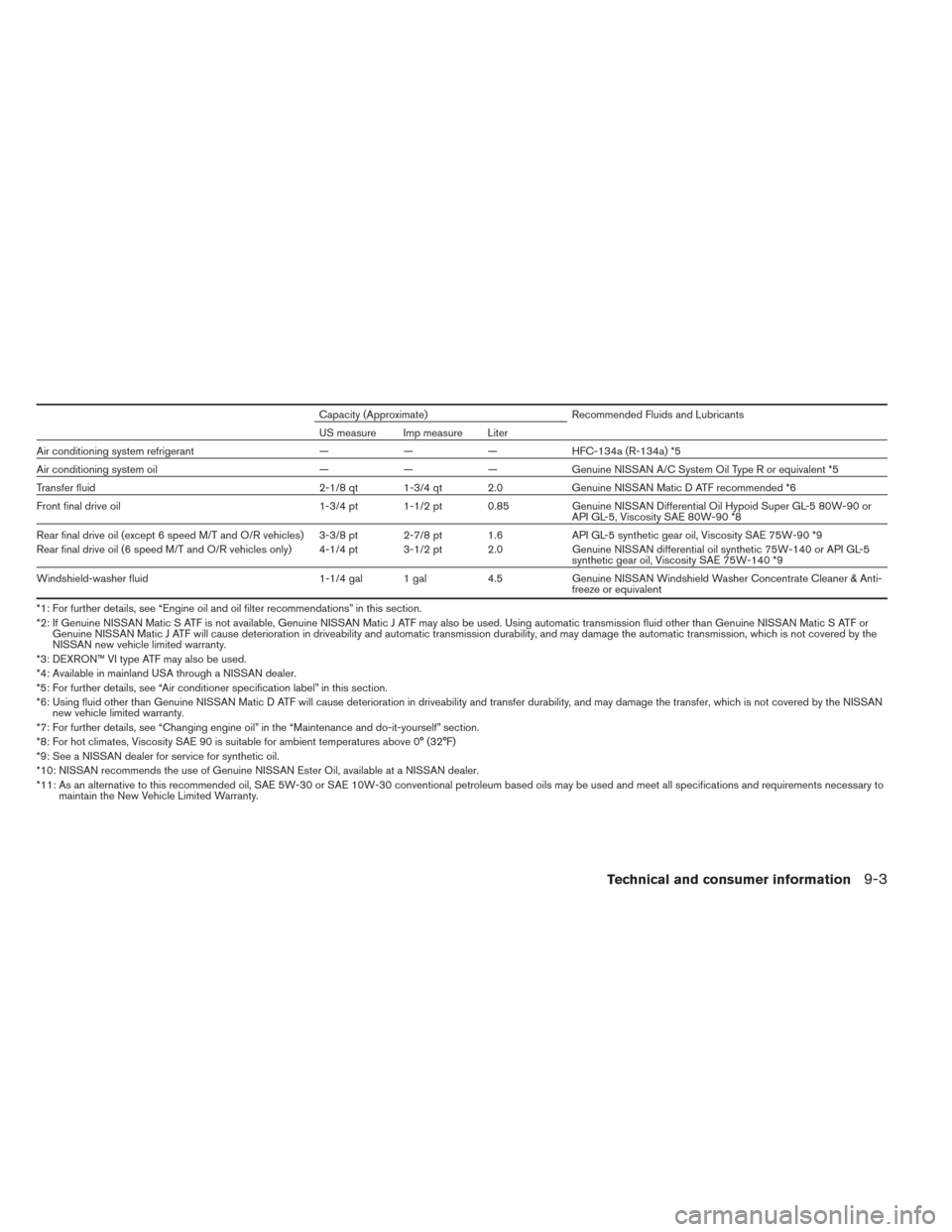
Capacity (Approximate)Recommended Fluids and Lubricants
US measure Imp measure Liter
Air conditioning system refrigerant ———HFC-134a (R-134a) *5
Air conditioning system oil ———Genuine NISSAN A/C System Oil Type R or equivalent *5
Transfer fluid 2-1/8 qt 1-3/4 qt 2.0Genuine NISSAN Matic D ATF recommended *6
Front final drive oil 1-3/4 pt 1-1/2 pt 0.85Genuine NISSAN Differential Oil Hypoid Super GL-5 80W-90 or
API GL-5, Viscosity SAE 80W-90 *8
Rear final drive oil (except 6 speed M/T and O/R vehicles) 3-3/8 pt 2-7/8 pt 1.6 API GL-5 synthetic gear oil, Viscosity SAE 75W-90 *9
Rear final drive oil (6 speed M/T and O/R vehicles only) 4-1/4 pt 3-1/2 pt 2.0 Genuine NISSAN differential oil synthetic 75W-140 or API GL-5
synthetic gear oil, Viscosity SAE 75W-140 *9
Windshield-washer fluid 1-1/4 gal 1 gal4.5Genuine NISSAN Windshield Washer Concentrate Cleaner & Anti-
freeze or equivalent
*1: For further details, see “Engine oil and oil filter recommendations” in this section.
*2: If Genuine NISSAN Matic S ATF is not available, Genuine NISSAN Matic J ATF may also be used. Using automatic transmission fluid other than Genuine NISSAN Matic S ATF or Genuine NISSAN Matic J ATF will cause deterioration in driveability and automatic transmission durability, and may damage the automatic transmission, which is not covered by the
NISSAN new vehicle limited warranty.
*3: DEXRON™ VI type ATF may also be used.
*4: Available in mainland USA through a NISSAN dealer.
*5: For further details, see “Air conditioner specification label” in this section.
*6: Using fluid other than Genuine NISSAN Matic D ATF will cause deterioration in driveability and transfer durability, and may damage the transfer, which is not covered by the NISSAN new vehicle limited warranty.
*7: For further details, see “Changing engine oil” in the “Maintenance and do-it-yourself” section.
*8: For hot climates, Viscosity SAE 90 is suitable for ambient temperatures above 0° (32°F)
*9: See a NISSAN dealer for service for synthetic oil.
*10: NISSAN recommends the use of Genuine NISSAN Ester Oil, available at a NISSAN dealer.
*11: As an alternative to this recommended oil, SAE 5W-30 or SAE 10W-30 conventional petroleum based oils may be used and meet all specifications and requirements necessary to maintain the New Vehicle Limited Warranty.
Technical and consumer information9-3
Page 418 of 434
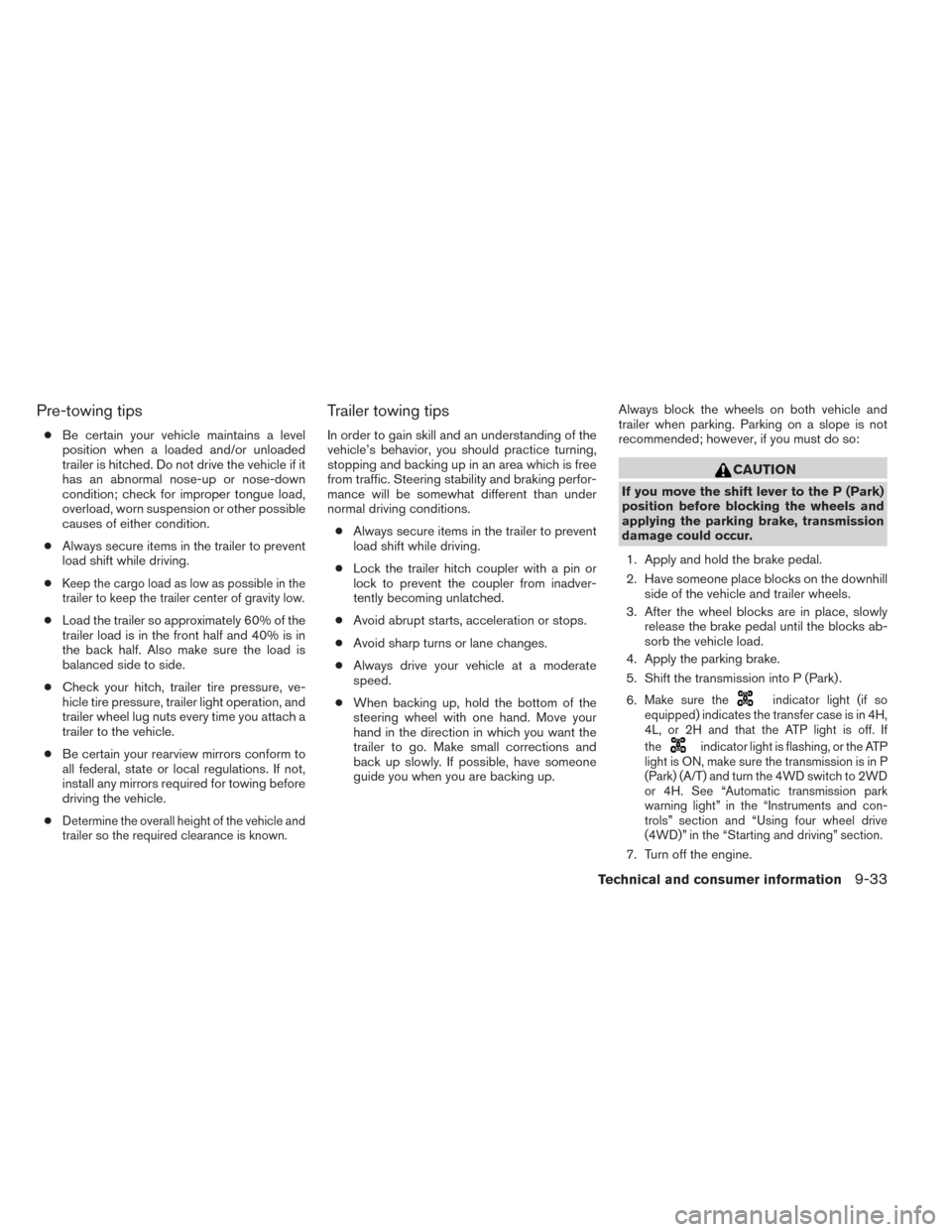
Pre-towing tips
●Be certain your vehicle maintains a level
position when a loaded and/or unloaded
trailer is hitched. Do not drive the vehicle if it
has an abnormal nose-up or nose-down
condition; check for improper tongue load,
overload, worn suspension or other possible
causes of either condition.
● Always secure items in the trailer to prevent
load shift while driving.
●
Keep the cargo load as low as possible in the
trailer to keep the trailer center of gravity low.
● Load the trailer so approximately 60% of the
trailer load is in the front half and 40% is in
the back half. Also make sure the load is
balanced side to side.
● Check your hitch, trailer tire pressure, ve-
hicle tire pressure, trailer light operation, and
trailer wheel lug nuts every time you attach a
trailer to the vehicle.
● Be certain your rearview mirrors conform to
all federal, state or local regulations. If not,
install any mirrors required for towing before
driving the vehicle.
●
Determine the overall height of the vehicle and
trailer so the required clearance is known.
Trailer towing tips
In order to gain skill and an understanding of the
vehicle’s behavior, you should practice turning,
stopping and backing up in an area which is free
from traffic. Steering stability and braking perfor-
mance will be somewhat different than under
normal driving conditions.
● Always secure items in the trailer to prevent
load shift while driving.
● Lock the trailer hitch coupler with a pin or
lock to prevent the coupler from inadver-
tently becoming unlatched.
● Avoid abrupt starts, acceleration or stops.
● Avoid sharp turns or lane changes.
● Always drive your vehicle at a moderate
speed.
● When backing up, hold the bottom of the
steering wheel with one hand. Move your
hand in the direction in which you want the
trailer to go. Make small corrections and
back up slowly. If possible, have someone
guide you when you are backing up. Always block the wheels on both vehicle and
trailer when parking. Parking on a slope is not
recommended; however, if you must do so:
CAUTION
If you move the shift lever to the P (Park)
position before blocking the wheels and
applying the parking brake, transmission
damage could occur.
1. Apply and hold the brake pedal.
2. Have someone place blocks on the downhill side of the vehicle and trailer wheels.
3. After the wheel blocks are in place, slowly release the brake pedal until the blocks ab-
sorb the vehicle load.
4. Apply the parking brake.
5. Shift the transmission into P (Park) .
6.
Make sure theindicator light (if so
equipped) indicates the transfer case is in 4H,
4L, or 2H and that the ATP light is off. If
the
indicator light is flashing, or the ATP
light is ON, make sure the transmission is in P
(Park) (A/T) and turn the 4WD switch to 2WD
or 4H. See “Automatic transmission park
warning light” in the “Instruments and con-
trols” section and “Using four wheel drive
(4WD)” in the “Starting and driving” section.
7. Turn off the engine.
Technical and consumer information9-33
Page 419 of 434
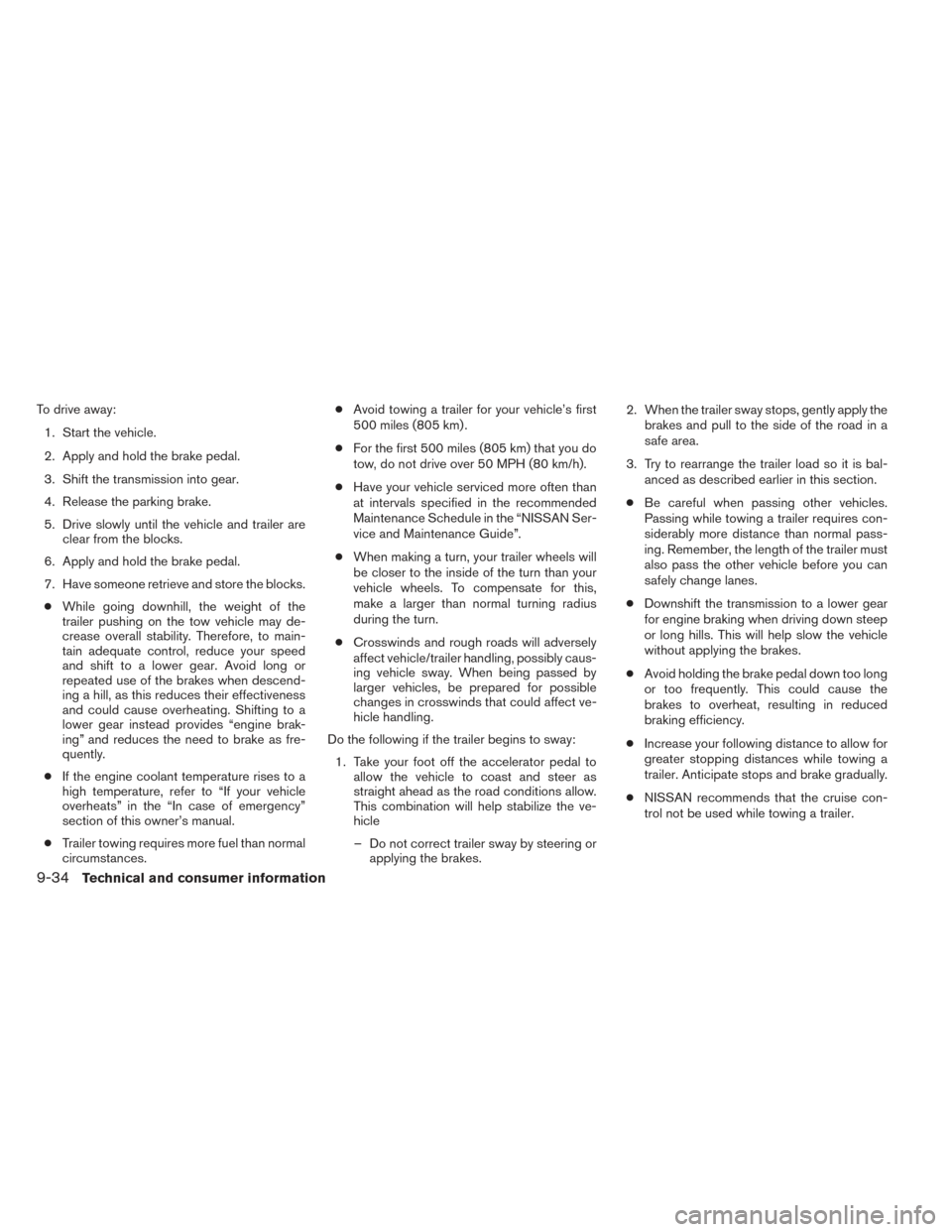
To drive away:1. Start the vehicle.
2. Apply and hold the brake pedal.
3. Shift the transmission into gear.
4. Release the parking brake.
5. Drive slowly until the vehicle and trailer are clear from the blocks.
6. Apply and hold the brake pedal.
7. Have someone retrieve and store the blocks. ● While going downhill, the weight of the
trailer pushing on the tow vehicle may de-
crease overall stability. Therefore, to main-
tain adequate control, reduce your speed
and shift to a lower gear. Avoid long or
repeated use of the brakes when descend-
ing a hill, as this reduces their effectiveness
and could cause overheating. Shifting to a
lower gear instead provides “engine brak-
ing” and reduces the need to brake as fre-
quently.
● If the engine coolant temperature rises to a
high temperature, refer to “If your vehicle
overheats” in the “In case of emergency”
section of this owner’s manual.
● Trailer towing requires more fuel than normal
circumstances. ●
Avoid towing a trailer for your vehicle’s first
500 miles (805 km) .
● For the first 500 miles (805 km) that you do
tow, do not drive over 50 MPH (80 km/h).
● Have your vehicle serviced more often than
at intervals specified in the recommended
Maintenance Schedule in the “NISSAN Ser-
vice and Maintenance Guide”.
● When making a turn, your trailer wheels will
be closer to the inside of the turn than your
vehicle wheels. To compensate for this,
make a larger than normal turning radius
during the turn.
● Crosswinds and rough roads will adversely
affect vehicle/trailer handling, possibly caus-
ing vehicle sway. When being passed by
larger vehicles, be prepared for possible
changes in crosswinds that could affect ve-
hicle handling.
Do the following if the trailer begins to sway: 1. Take your foot off the accelerator pedal to allow the vehicle to coast and steer as
straight ahead as the road conditions allow.
This combination will help stabilize the ve-
hicle
– Do not correct trailer sway by steering or applying the brakes. 2. When the trailer sway stops, gently apply the
brakes and pull to the side of the road in a
safe area.
3. Try to rearrange the trailer load so it is bal- anced as described earlier in this section.
● Be careful when passing other vehicles.
Passing while towing a trailer requires con-
siderably more distance than normal pass-
ing. Remember, the length of the trailer must
also pass the other vehicle before you can
safely change lanes.
● Downshift the transmission to a lower gear
for engine braking when driving down steep
or long hills. This will help slow the vehicle
without applying the brakes.
● Avoid holding the brake pedal down too long
or too frequently. This could cause the
brakes to overheat, resulting in reduced
braking efficiency.
● Increase your following distance to allow for
greater stopping distances while towing a
trailer. Anticipate stops and brake gradually.
● NISSAN recommends that the cruise con-
trol not be used while towing a trailer.
9-34Technical and consumer information
Page 420 of 434
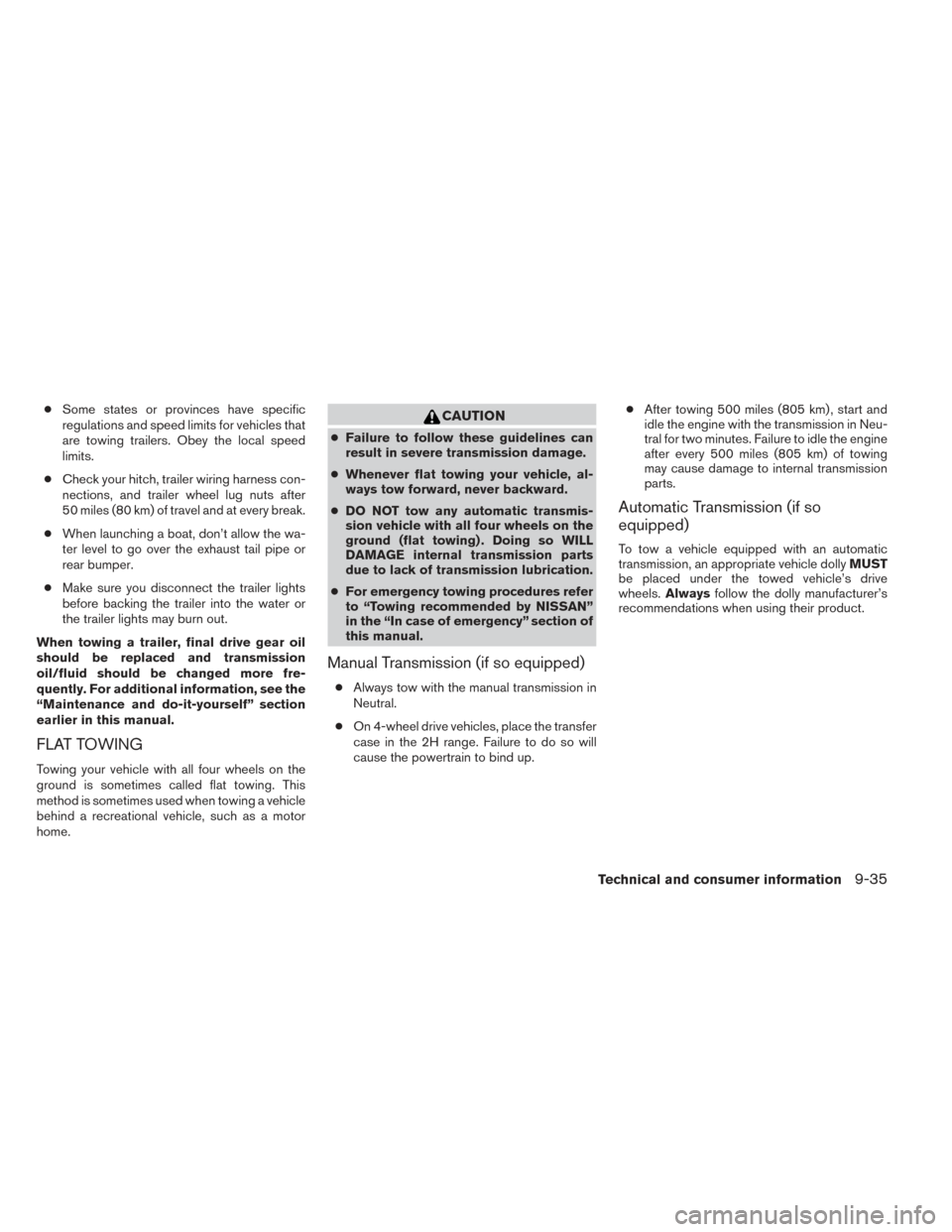
●Some states or provinces have specific
regulations and speed limits for vehicles that
are towing trailers. Obey the local speed
limits.
● Check your hitch, trailer wiring harness con-
nections, and trailer wheel lug nuts after
50 miles (80 km) of travel and at every break.
● When launching a boat, don’t allow the wa-
ter level to go over the exhaust tail pipe or
rear bumper.
● Make sure you disconnect the trailer lights
before backing the trailer into the water or
the trailer lights may burn out.
When towing a trailer, final drive gear oil
should be replaced and transmission
oil/fluid should be changed more fre-
quently. For additional information, see the
“Maintenance and do-it-yourself” section
earlier in this manual.
FLAT TOWING
Towing your vehicle with all four wheels on the
ground is sometimes called flat towing. This
method is sometimes used when towing a vehicle
behind a recreational vehicle, such as a motor
home.
CAUTION
● Failure to follow these guidelines can
result in severe transmission damage.
● Whenever flat towing your vehicle, al-
ways tow forward, never backward.
● DO NOT tow any automatic transmis-
sion vehicle with all four wheels on the
ground (flat towing) . Doing so WILL
DAMAGE internal transmission parts
due to lack of transmission lubrication.
● For emergency towing procedures refer
to “Towing recommended by NISSAN”
in the “In case of emergency” section of
this manual.
Manual Transmission (if so equipped)
● Always tow with the manual transmission in
Neutral.
● On 4-wheel drive vehicles, place the transfer
case in the 2H range. Failure to do so will
cause the powertrain to bind up. ●
After towing 500 miles (805 km) , start and
idle the engine with the transmission in Neu-
tral for two minutes. Failure to idle the engine
after every 500 miles (805 km) of towing
may cause damage to internal transmission
parts.
Automatic Transmission (if so
equipped)
To tow a vehicle equipped with an automatic
transmission, an appropriate vehicle dolly MUST
be placed under the towed vehicle’s drive
wheels. Always follow the dolly manufacturer’s
recommendations when using their product.
Technical and consumer information9-35
Page 423 of 434
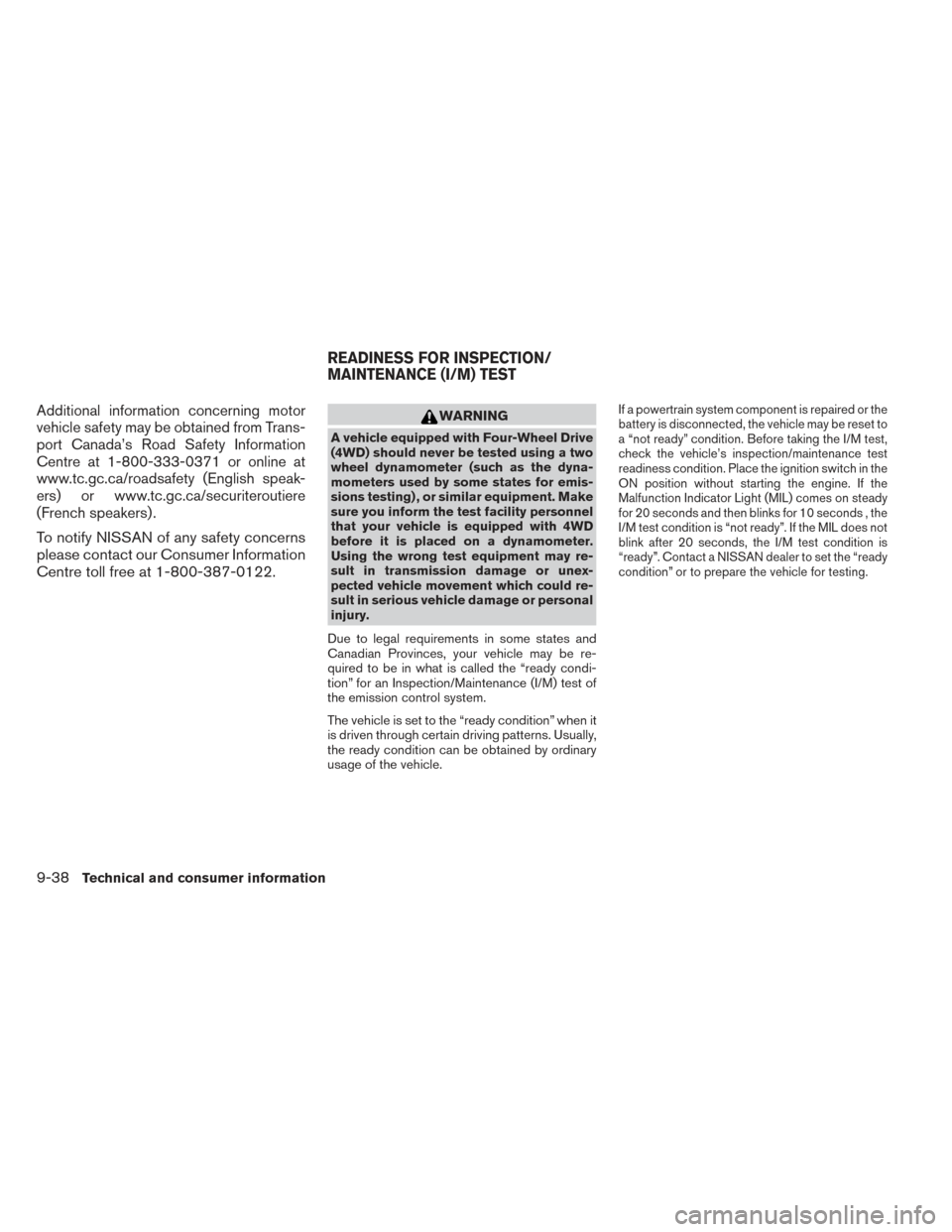
Additional information concerning motor
vehicle safety may be obtained from Trans-
port Canada’s Road Safety Information
Centre at 1-800-333-0371 or online at
www.tc.gc.ca/roadsafety (English speak-
ers) or www.tc.gc.ca/securiteroutiere
(French speakers) .
To notify NISSAN of any safety concerns
please contact our Consumer Information
Centre toll free at 1-800-387-0122.
WARNING
A vehicle equipped with Four-Wheel Drive
(4WD) should never be tested using a two
wheel dynamometer (such as the dyna-
mometers used by some states for emis-
sions testing) , or similar equipment. Make
sure you inform the test facility personnel
that your vehicle is equipped with 4WD
before it is placed on a dynamometer.
Using the wrong test equipment may re-
sult in transmission damage or unex-
pected vehicle movement which could re-
sult in serious vehicle damage or personal
injury.
Due to legal requirements in some states and
Canadian Provinces, your vehicle may be re-
quired to be in what is called the “ready condi-
tion” for an Inspection/Maintenance (I/M) test of
the emission control system.
The vehicle is set to the “ready condition” when it
is driven through certain driving patterns. Usually,
the ready condition can be obtained by ordinary
usage of the vehicle.
If a powertrain system component is repaired or the
battery is disconnected, the vehicle may be reset to
a “not ready” condition. Before taking the I/M test,
check the vehicle’s inspection/maintenance test
readiness condition. Place the ignition switch in the
ON position without starting the engine. If the
Malfunction Indicator Light (MIL) comes on steady
for 20 seconds and then blinks for 10 seconds , the
I/M test condition is “not ready”. If the MIL does not
blink after 20 seconds, the I/M test condition is
“ready”. Contact a NISSAN dealer to set the “ready
condition” or to prepare the vehicle for testing.
READINESS FOR INSPECTION/
MAINTENANCE (I/M) TEST
9-38Technical and consumer information
Page 426 of 434
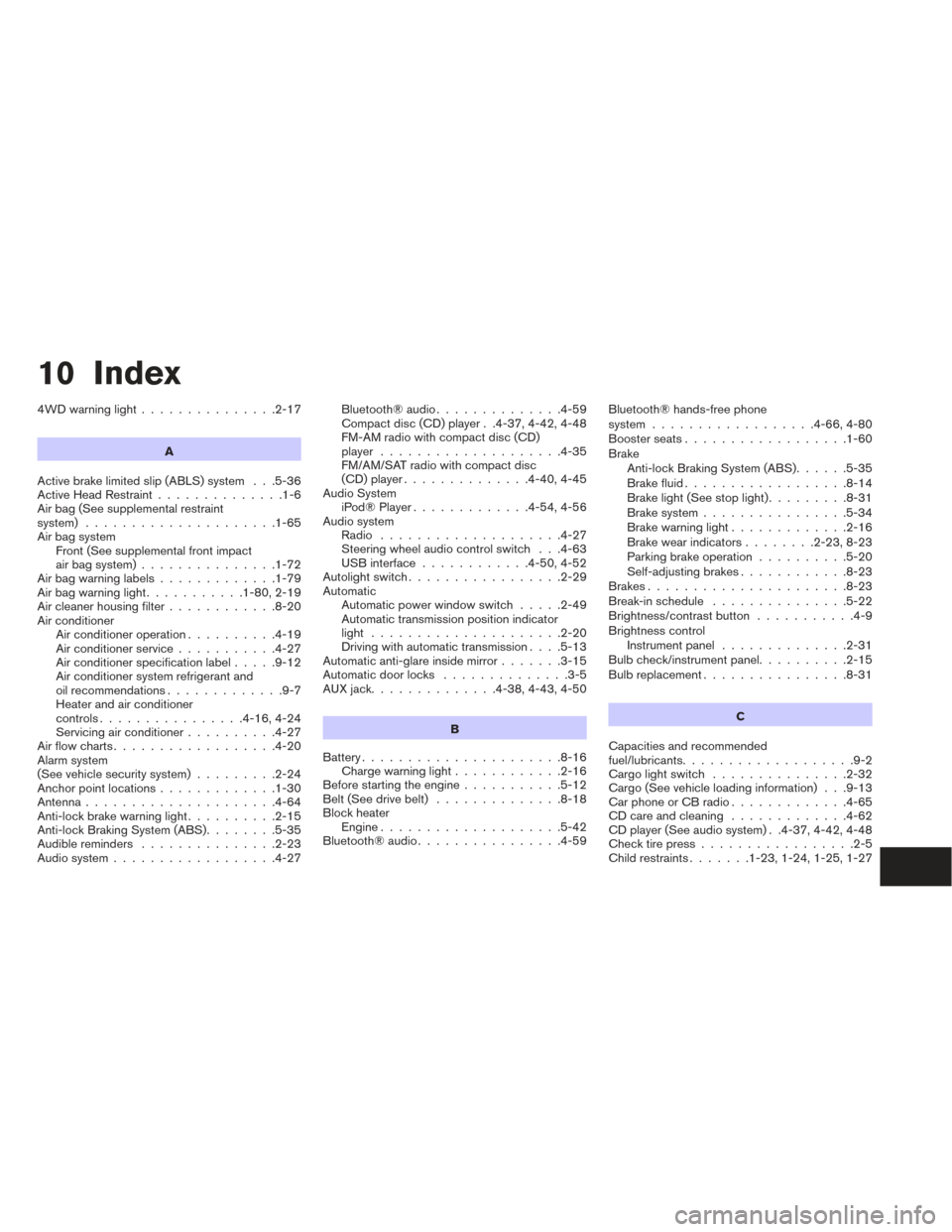
10 Index
4WDwarninglight...............2-17A
Active brake limited slip (ABLS) system . . .5-36
Active Head Restraint ..............1-6
Air bag (See supplemental restraint
system) .....................1-65
Air bag system Front (See supplemental front impact
air bag system) ...............1-72
Airbagwarninglabels.............1-79
Airbagwarninglight...........1-80,2-19
Air cleaner housing filter ............8-20
Air conditioner Air conditioner operation ..........4-19
Air conditioner service ...........4-27
Air conditioner specification label .....9-12
Air conditioner system refrigerant and
oil recommendations .............9-7
Heater and air conditioner
controls................4-16,4-24
Servicing air conditioner ..........4-27
Airflowcharts..................4-20
Alarm system
(See vehicle security system) .........2-24
Anchor point locations .............1-30
Antenna.....................4-64
Anti-lock brake warning light ..........2-15
Anti-lock Braking System (ABS) ........5-35
Audible reminders ...............2-23
Audio system ..................4-27 Bluetooth®audio..............4-59
Compact disc (CD) player . .4-37, 4-42, 4-48
FM-AM radio with compact disc (CD)
player ....................4-35
FM/AM/SAT radio with compact disc
(CD) player
..............4-40,4-45
Audio System iPod®Player.............4-54,4-56
Audio system Radio ....................4-27
Steering wheel audio control switch . . .4-63
USB interface ............4-50,4-52
Autolight switch .................2-29
Automatic Automatic power window switch .....2-49
Automatic transmission position indicator
light .....................2-20
Driving with automatic transmission ....5-13
Automatic anti-glare inside mirror .......3-15
Automatic door locks ..............3-5
AUXjack..............4-38,4-43,4-50
B
Battery ......................8-16
Charge warning light ............2-16
Before starting the engine ...........5-12
Belt (See drive belt) ..............8-18
Block heater Engine ....................5-42
Bluetooth®audio................4-59 Bluetooth® hands-free phone
system
..................4-66,4-80
Boosterseats..................1-60
Brake Anti-lock Braking System (ABS) ......5-35
Brakefluid..................8-14
Brakelight(Seestoplight).........8-31
Brake system ................5-34
Brake warning light .............2-16
Brake wear indicators ........2-23,8-23
Parking brake operation ..........5-20
Self-adjusting brakes ............8-23
Brakes ......................8-23
Break-inschedule ...............5-22
Brightness/contrast button ...........4-9
Brightness control Instrument panel ..............2-31
Bulb check/instrument panel ..........2-15
Bulbreplacement................8-31
C
Capacities and recommended
fuel/lubricants ...................9-2
Cargo light switch ...............2-32
Cargo (See vehicle loading information) . . .9-13
Car phone or CB radio .............4-65
CD care and cleaning .............4-62
CD
player (See audio system) . .4-37, 4-42, 4-48
Check tire press .................2-5
Child restraints .......1-23,1-24,1-25,1-27
Page 427 of 434
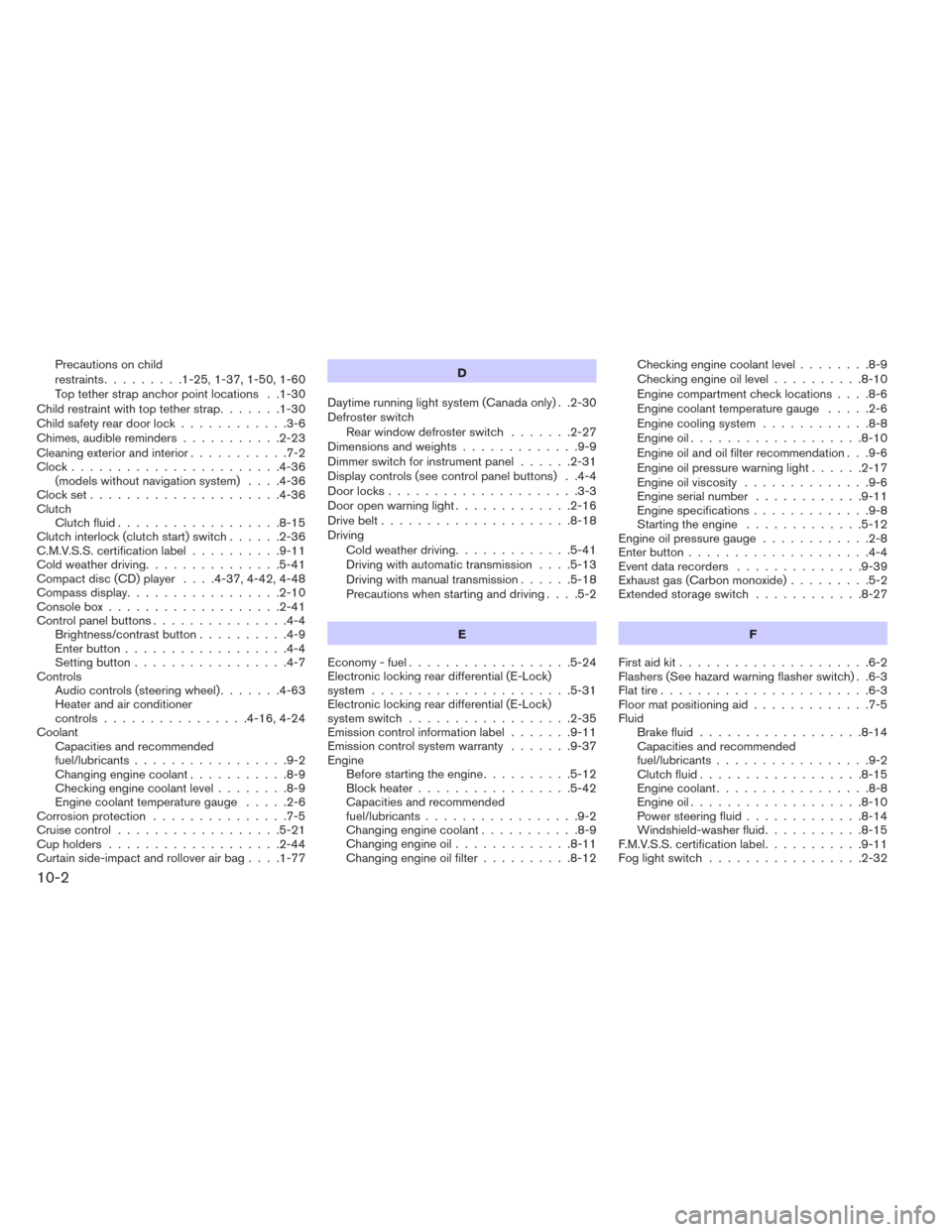
Precautions on child
restraints.........1-25,1-37,1-50,1-60
Top tether strap anchor point locations . .1-30
Child restraint with top tether strap .......1-30
Child safety rear door lock ............3-6
Chimes, audible reminders ...........2-23
Cleaning exterior and interior ...........7-2
Clock.......................4-36 (models without navigation system) ....4-36
Clockset.....................4-36
Clutch Clutch fluid ..................8-15
Clutch interlock (clutch start) switch ......2-36
C.M.V.S.S. certification label ..........9-11
Cold weather driving ...............5-41
Compact disc (CD) player ....4-37,4-42,4-48
Compass display .................2-10
Consolebox...................2-41
Control panel buttons ...............4-4
Brightness/contrast button ..........4-9
Enterbutton..................4-4
Setting button .................4-7
Controls Audiocontrols(steeringwheel).......4-63
Heater and air conditioner
controls ................4-16,4-24
Coolant Capacities and recommended
fuel/lubricants .................9-2
Changing engine coolant ...........8-9
Checking engine coolant level ........8-9
Engine coolant temperature gauge .....2-6
Corrosionprotection ...............7-5
Cruisecontrol..................5-21
Cupholders...................2-44
Curtainside-impactandrolloverairbag....1-77 D
Daytime running light system (Canada only) . .2-30
Defroster switch Rear window defroster switch .......2-27
Dimensionsandweights.............9-9
Dimmer switch for instrument panel ......2-31
Display controls (see control panel buttons) . .4-4
Door locks .....................3-3
Door open warning light .............2-16
Drive belt .....................8-18
Driving Cold weather driving .............5-41
Driving with automatic transmission ....5-13
Driving with manual transmission ......5-18
Precautions when starting and driving ....5-2
E
Economy - fuel ..................5-24
Electronic locking rear differential (E-Lock)
system ......................5-31
Electronic locking rear differential (E-Lock)
system switch ..................2-35
Emission control information label .......9-11
Emission control system warranty .......9-37
Engine Before starting the engine ..........5-12
Block heater .................5-42
Capacities and recommended
fuel/lubricants .................9-2
Changingenginecoolant...........8-9
Changingengineoil.............8-11
Changing engine oil filter ..........8-12 Checking engine coolant level
........8-9
Checking engine oil level ..........8-10
Engine compartment check locations ....8-6
Engine coolant temperature gauge .....2-6
Engine cooling system ............8-8
Engine oil ...................8-10
Engine
oil and oil filter recommendation . . .9-6
Engine oil pressure warning light ......2-17
Engine oil viscosity ..............9-6
Engine serial number ............9-11
Engine specifications .............9-8
Starting the engine .............5-12
Engine oil pressure gauge ............2-8
Enterbutton....................4-4
Eventdatarecorders ..............9-39
Exhaustgas(Carbonmonoxide).........5-2
Extended storage switch ............8-27
F
First aid kit .....................6-2
Flashers (See hazard warning flasher switch) . .6-3
Flat tire .......................6-3
Floor mat positioning aid .............7-5
Fluid Brake fluid ..................8-14
Capacities and recommended
fuel/lubricants .................9-2
Clutchfluid..................8-15
Engine coolant .................8-8
Engine oil ...................8-10
Power steering fluid .............8-14
Windshield-washer fluid ...........8-15
F.M.V.S.S. certification label ...........9-11
Foglightswitch .................2-32
10-2
Page 430 of 434
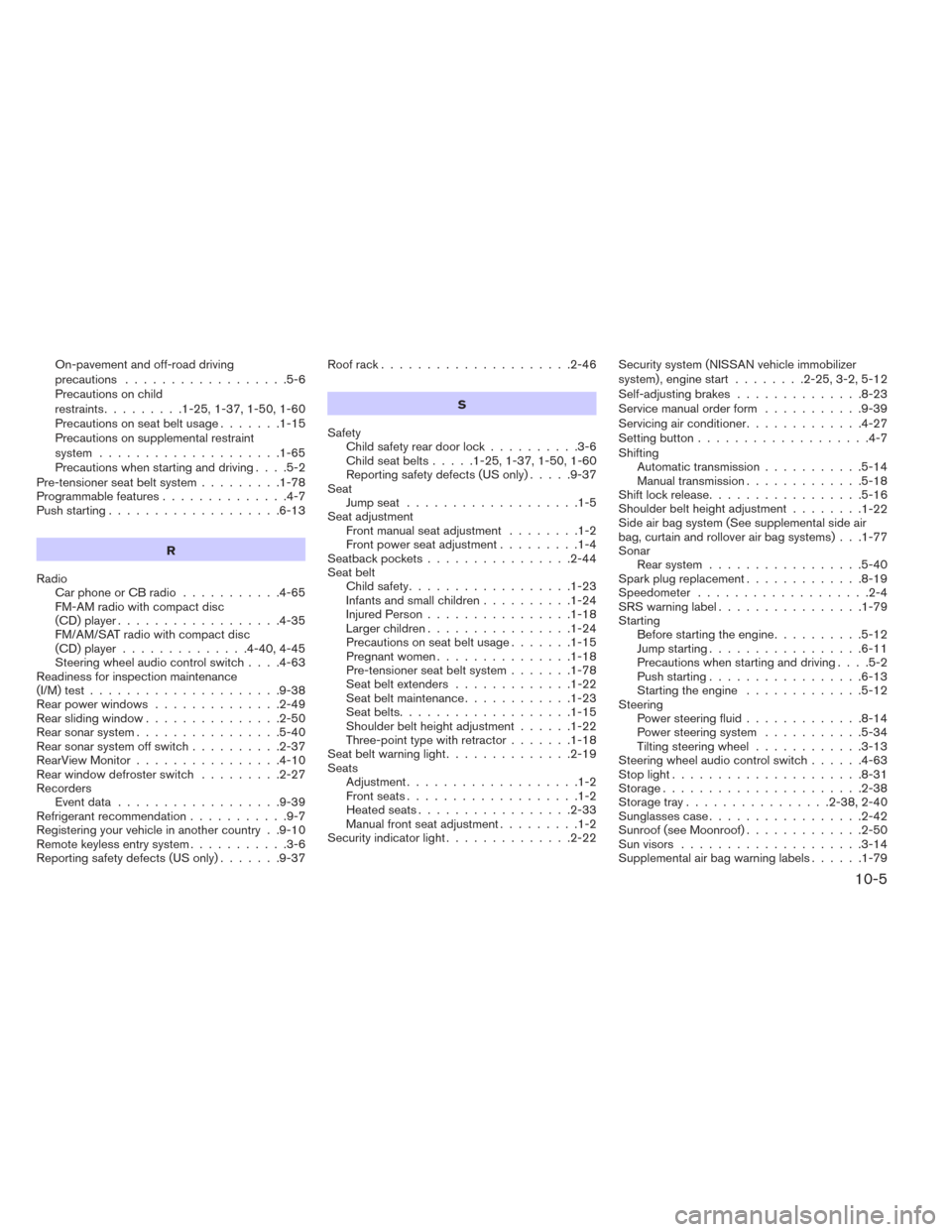
On-pavement and off-road driving
precautions..................5-6
Precautions on child
restraints .........1-25,1-37,1-50,1-60
Precautionsonseatbeltusage.......1-15
Precautions on supplemental restraint
system ....................1-65
Precautions when starting and driving ....5-2
Pre-tensioner seat belt system .........1-78
Programmable features ..............4-7
Push starting ...................6-13
R
Radio Car phone or CB radio ...........4-65
FM-AM radio with compact disc
(CD) player ..................4-35
FM/AM/SAT radio with compact disc
(CD) player ..............4-40,4-45
Steering wheel audio control switch ....4-63
Readiness for inspection maintenance
(I/M) test .....................9-38
Rear power windows ..............2-49
Rear sliding window ...............2-50
Rear sonar system ................5-40
Rear sonar system off switch ..........2-37
RearViewMonitor................4-10
Rear window defroster switch .........2-27
Recorders Eventdata..................9-39
Refrigerant recommendation ...........9-7
Registering your vehicle in another country . .9-10
Remote keyless entry system ...........3-6
Reporting safety defects (US only) .......9-37Roof rack
.....................2-46
S
Safety Child safety rear door lock ..........3-6
Childseatbelts.....1-25,1-37,1-50,1-60
Reporting safety defects (US only) .....9-37
Seat Jumpseat ...................1-5
Seat adjustment Frontmanualseatadjustment ........1-2
Front power seat adjustment .........1-4
Seatback pockets ................2-44
Seat belt Child safety ..................1-23
Infants and small children ..........1-24
Injured Person ................1-18
Largerchildren................1-24
Precautions on seat belt usage .......1-15
Pregnant women ...............1-18
Pre-tensioner seat belt system .......1-78
Seatbeltextenders .............1-22
Seatbeltmaintenance............1-23
Seatbelts...................1-15
Shoulder belt height adjustment ......1-22
Three-point type with retractor .......1-18
Seat belt warning light ..............2-19
Seats Adjustment ...................1-2
Frontseats...................1-2
Heatedseats.................2-33
Manual front seat adjustment .........1-2
Security indicator light ..............2-22 Security system (NISSAN vehicle immobilizer
system) , engine start
........2-25,3-2,5-12
Self-adjusting brakes ..............8-23
Service manual order form ...........9-39
Servicing air conditioner .............4-27
Setting button ...................4-7
Shifting Automatic transmission ...........5-14
Manual transmission .............5-18
Shiftlockrelease.................5-16
Shoulder belt height adjustment ........
1-22
Side air bag system (See supplemental side air
bag, curtain and rollover air bag systems) . . .1-77
Sonar Rear system .................5-40
Spark plug replacement .............8-19
Speedometer ...................2-4
SRSwarninglabel................1-79
Starting Before starting the engine ..........5-12
Jump starting .................6-11
Precautions when starting and driving ....5-2
Push starting .................6-13
Starting the engine .............5-12
Steering Power steering fluid .............8-14
Power steering system ...........5-34
Tilting steering wheel ............3-13
Steering wheel audio control switch ......4-63
Stoplight.....................8-31
Storage......................2-38
Storage tray ................2-38,2-40
Sunglasses case .................2-42
Sunroof (see Moonroof) .............2-50
Sun visors ....................3-14
Supplemental air bag warning labels ......1-79
10-5